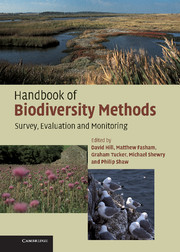Book contents
- Frontmatter
- Contents
- Preface
- Acknowledgements
- Part I Planning
- Part II Habitats
- Part III Species
- Appendix 1 Monitoring and reporting obligations under international conservation agreements
- Appendix 2 Relationship between BAP Priority Habitat and Broad Habitat categories and Habitats Directive nomenclature
- Appendix 3 Annotated list of key references for plant identification
- Appendix 4 Determining appropriate quadrat size for vegetation sampling
- Appendix 5 The relocation of permanent plots
- Appendix 6 Equipment required for undertaking different types of survey
- Recommended sources of further information
- References
- Glossary
- Index
Appendix 4 - Determining appropriate quadrat size for vegetation sampling
Published online by Cambridge University Press: 01 September 2010
- Frontmatter
- Contents
- Preface
- Acknowledgements
- Part I Planning
- Part II Habitats
- Part III Species
- Appendix 1 Monitoring and reporting obligations under international conservation agreements
- Appendix 2 Relationship between BAP Priority Habitat and Broad Habitat categories and Habitats Directive nomenclature
- Appendix 3 Annotated list of key references for plant identification
- Appendix 4 Determining appropriate quadrat size for vegetation sampling
- Appendix 5 The relocation of permanent plots
- Appendix 6 Equipment required for undertaking different types of survey
- Recommended sources of further information
- References
- Glossary
- Index
Summary
The size of a quadrat affects the measured values of frequency, density, and cover, etc. (see Figure A4.1 below). It is therefore important to decide in advance which values are to be measured. Experience has shown that different vegetation types and different measurement types require different quadrat sizes. In Part II, quadrat methods for habitat monitoring are described in Sections 6.4.2 (frame quadrats for cover and density estimates); 6.4.3 (random mini-quadrats for frequency estimates); 6.4.4 (FIBS analysis); and 6.4.5 (point quadrats). Quadrat size is also considered in the section on NVC mapping (Section 6.1.6). In Part III, the chapters on species groups and Chapter 10 also contain discussions of quadrat methods, where appropriate to the species group concerned.
This appendix deals with the selection of the appropriate quadrat size. Methods for calculating the number of quadrats required are given in Part I, Section 2.3.4. Frequency estimates are given the most attention, because quadrat size affects frequency measures more than others (see Figure A4.1). However, the lists of optimum quadrat size for different vegetation types can generally be applied to all quadrat sampling methods (with the obvious exception of point quadrats).
Techniques for determining optimum quadrat size for frequency measures are subjective, and a quadrat of any size will sample some species more adequately than others. The quadrat size chosen will therefore depend upon the type of vegetation being sampled. The use of random mini-quadrats for estimating frequency is described in Part II, Section 6.4.3.
- Type
- Chapter
- Information
- Handbook of Biodiversity MethodsSurvey, Evaluation and Monitoring, pp. 493 - 494Publisher: Cambridge University PressPrint publication year: 2005
- 1
- Cited by



